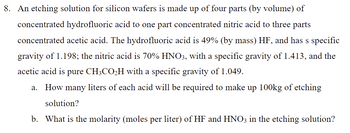
Introduction to Chemical Engineering Thermodynamics
8th Edition
ISBN: 9781259696527
Author: J.M. Smith Termodinamica en ingenieria quimica, Hendrick C Van Ness, Michael Abbott, Mark Swihart
Publisher: McGraw-Hill Education
expand_more
expand_more
format_list_bulleted
Question

Transcribed Image Text:8. An etching solution for silicon wafers is made up of four parts (by volume) of
concentrated hydrofluoric acid to one part concentrated nitric acid to three parts
concentrated acetic acid. The hydrofluoric acid is 49% (by mass) HF, and has s specific
gravity of 1.198; the nitric acid is 70% HNO3, with a specific gravity of 1.413, and the
acetic acid is pure CH3CO₂H with a specific gravity of 1.049.
a. How many liters of each acid will be required to make up 100kg of etching
solution?
b. What is the molarity (moles per liter) of HF and HNO3 in the etching solution?
Expert Solution
This question has been solved!
Explore an expertly crafted, step-by-step solution for a thorough understanding of key concepts.
This is a popular solution
Trending nowThis is a popular solution!
Step by stepSolved in 4 steps with 10 images

Knowledge Booster
Similar questions
- A mixture of gases has the following composition by mass (kg): Methanol Ethanol Propanol Water CH3OH C₂H5OH C3H7OH H₂O 2.00 80.0 5.00 20.0 a) What is the mixture composition in mass fractions? b) What is the mixture composition in mole fractions? Atomic masses (g/mol) are: 1, 12, and 16 for H, C, and O, respectively. c) What is the average molecular weight of this mixture? d) What is the mole fraction of propanol if all of the water is removed?arrow_forward10.73 The normal melting point of benzene, C,H, is 5.5°C. For process of melting, what is the sign of each of the fol- lowing? (a) AH°, (b) AS°, (c) AG° at 5.5°C, (d) AG° at 0.0°C, (e) AG° at 25.0°C thearrow_forward1)For Magnesium (Mg) with a HCP crystal structure. 1a) Show volume of the unit cell given by 6√3R³c. 1b) With the atomic radius of 0.160 mm and a density of 1.74 g/cm³ for Mg, Calculate the c/a ratio of the unit cell.arrow_forward
Recommended textbooks for you
 Introduction to Chemical Engineering Thermodynami...Chemical EngineeringISBN:9781259696527Author:J.M. Smith Termodinamica en ingenieria quimica, Hendrick C Van Ness, Michael Abbott, Mark SwihartPublisher:McGraw-Hill Education
Introduction to Chemical Engineering Thermodynami...Chemical EngineeringISBN:9781259696527Author:J.M. Smith Termodinamica en ingenieria quimica, Hendrick C Van Ness, Michael Abbott, Mark SwihartPublisher:McGraw-Hill Education Elementary Principles of Chemical Processes, Bind...Chemical EngineeringISBN:9781118431221Author:Richard M. Felder, Ronald W. Rousseau, Lisa G. BullardPublisher:WILEY
Elementary Principles of Chemical Processes, Bind...Chemical EngineeringISBN:9781118431221Author:Richard M. Felder, Ronald W. Rousseau, Lisa G. BullardPublisher:WILEY Elements of Chemical Reaction Engineering (5th Ed...Chemical EngineeringISBN:9780133887518Author:H. Scott FoglerPublisher:Prentice Hall
Elements of Chemical Reaction Engineering (5th Ed...Chemical EngineeringISBN:9780133887518Author:H. Scott FoglerPublisher:Prentice Hall
 Industrial Plastics: Theory and ApplicationsChemical EngineeringISBN:9781285061238Author:Lokensgard, ErikPublisher:Delmar Cengage Learning
Industrial Plastics: Theory and ApplicationsChemical EngineeringISBN:9781285061238Author:Lokensgard, ErikPublisher:Delmar Cengage Learning Unit Operations of Chemical EngineeringChemical EngineeringISBN:9780072848236Author:Warren McCabe, Julian C. Smith, Peter HarriottPublisher:McGraw-Hill Companies, The
Unit Operations of Chemical EngineeringChemical EngineeringISBN:9780072848236Author:Warren McCabe, Julian C. Smith, Peter HarriottPublisher:McGraw-Hill Companies, The

Introduction to Chemical Engineering Thermodynami...
Chemical Engineering
ISBN:9781259696527
Author:J.M. Smith Termodinamica en ingenieria quimica, Hendrick C Van Ness, Michael Abbott, Mark Swihart
Publisher:McGraw-Hill Education

Elementary Principles of Chemical Processes, Bind...
Chemical Engineering
ISBN:9781118431221
Author:Richard M. Felder, Ronald W. Rousseau, Lisa G. Bullard
Publisher:WILEY

Elements of Chemical Reaction Engineering (5th Ed...
Chemical Engineering
ISBN:9780133887518
Author:H. Scott Fogler
Publisher:Prentice Hall


Industrial Plastics: Theory and Applications
Chemical Engineering
ISBN:9781285061238
Author:Lokensgard, Erik
Publisher:Delmar Cengage Learning

Unit Operations of Chemical Engineering
Chemical Engineering
ISBN:9780072848236
Author:Warren McCabe, Julian C. Smith, Peter Harriott
Publisher:McGraw-Hill Companies, The